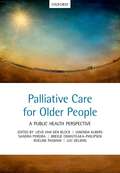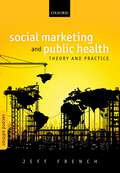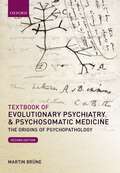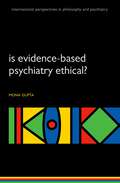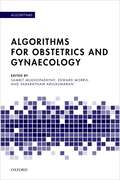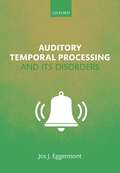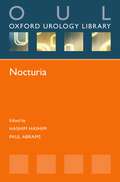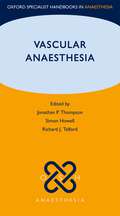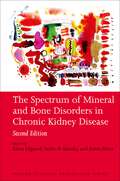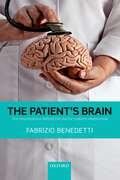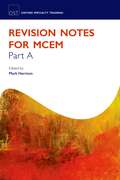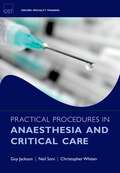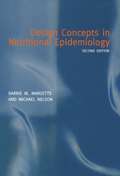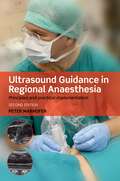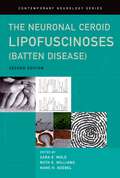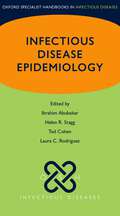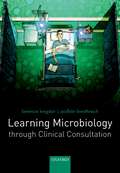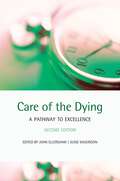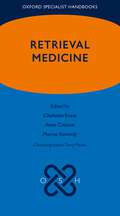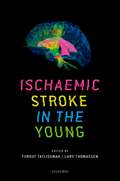- Table View
- List View
Palliative care for older people: A public health perspective
by Lieve Van den Block, Gwenda Albers, Sandra Martins Pereira, Bregje Onwuteaka-Philipsen, Roeline Pasmanand and Luc DeliensCurrent projections indicate that by 2050 the number of people aged over 80 years old will rise to 395 million and that by this date 25-30% of people over the age of 85 will show some degree of cognitive decline. Palliative care for older people: A public health perspective provides a comprehensive account of the current state of palliative care for older people worldwide and illustrates the range of concomitant issues that, as the global population ages, will ever more acutely shape the decisions of policy-makers and care-givers. The book begins by outlining the range of policies towards palliative care for older people that are found worldwide. It follows this by examining an array of socio-cultural issues and palliative care initiatives, from the care implications of health trajectories of older people to the spiritual requirements of palliative care patients, and from the need to encourage compassion towards end-of-life care within communities to the development of care pathways for older people. Palliative care for older people: A public health perspective is a valuable resource for professionals and academics in a range of healthcare and public health fields to understand the current state of policy work from around the world. The book also highlights the social-cultural considerations that influence the difficult decisions that those involved in palliative care face, not least patients themselves, and offers examples of good practice and recommendations to inspire, support, and direct healthcare policy and decision-making at organisational, regional, national and international levels.
Social Marketing and Public Health: Theory and Practice
The last ten years have seen tremendous advances in the theory and practice base of social marketing globally. Social Marketing and Public Health: Theory and Practice introduces new conceptual models and approaches to influence behaviour that promotes health and prevents disease. This new edition moves the book's focus to a globally-relevant approach to the application and evaluation of social marketing, and includes a range of international case studies. In addition to coverage of key concepts and techniques in social marketing, this book contains chapters on areas such as marketing on a budget, ethical issues, and incorporating digital and social media platforms into social marketing strategies. A practical 'how to' guide; Social Marketing and Public Health empowers citizens by understanding their needs and working together to create healthy communities. It sets out a compelling case for a more citizen, patient, or client-focused approach to promoting health and preventing disease, which is the core of good social marketing practice. Written by international experts in the field, this book is a useful guide for public health specialist planners and policy makers, social marketing organisations and professionals, and students and academics in these fields.
Social Marketing and Public Health: Theory and Practice
by Jeff FrenchThe last ten years have seen tremendous advances in the theory and practice base of social marketing globally. Social Marketing and Public Health: Theory and Practice introduces new conceptual models and approaches to influence behaviour that promotes health and prevents disease. This new edition moves the book's focus to a globally-relevant approach to the application and evaluation of social marketing, and includes a range of international case studies. In addition to coverage of key concepts and techniques in social marketing, this book contains chapters on areas such as marketing on a budget, ethical issues, and incorporating digital and social media platforms into social marketing strategies. A practical 'how to' guide; Social Marketing and Public Health empowers citizens by understanding their needs and working together to create healthy communities. It sets out a compelling case for a more citizen, patient, or client-focused approach to promoting health and preventing disease, which is the core of good social marketing practice. Written by international experts in the field, this book is a useful guide for public health specialist planners and policy makers, social marketing organisations and professionals, and students and academics in these fields.
Textbook of Evolutionary Psychiatry and Psychosomatic Medicine: The Origins of Psychopathology
by Martin BrünePsychiatry and Psychosomatic Medicine are concerned with medical conditions affecting brain, mind and behaviour in manifold ways. Traditional approaches have focused on a restricted array of potential causes of psychiatric and psychosomatic conditions - including adverse experiences such as trauma, neglect or abuse, genetic vulnerability and epigenetic regulation of gene expression. Whilst essential for the understanding of mental disorders, these approaches have disregarded important questions such as why the human mind is vulnerable to dysfunction at all. The Textbook of Evolutionary Psychiatry and Psychosomatic Medicine updates and expands the previous edition to provide answers to these questions by emphasising an evolutionary perspective on psychiatric and psychosomatic conditions. It explains how the human brain/mind has been shaped by natural and sexual selection; why adaptations to environmental conditions in our evolutionary past may nowadays work in suboptimal ways; and how human cognition, emotions, and behaviour can be scientifically framed to improve our understanding of how people try to attain important biosocial goals pertaining to one's status in society, mating, eliciting and providing care, and maintaining rewarding relationships. The evolutionary topics relevant to the understanding of psychiatric and psychosomatic conditions include the concepts of genetic plasticity, life history theory, stress regulation and immunological aspects. In addition, it is argued that an evolutionary framework is also necessary to understand how psychotherapy and psychopharmacology work to improve the lives of patients with psychiatric and psychosomatic disorders. The Textbook of Evolutionary Psychiatry and Psychosomatic Medicine is a valuable text for all students of Psychology, Medicine, and Psychotherapy who seek an understanding of the evolutionary issues surrounding health and disease.
Is Evidence-based Psychiatry Ethical? (International Perspectives In Philosophy And Psychiatry Ser.)
by Mona GuptaRated as one of the top 15 breakthroughs in medicine over the last 150 years, evidence-based medicine (EBM) has become highly influential in medicine. Put simply, EBM promotes a seemingly irrefutable, principle: that decision-making in medical practice should be based, as much as possible, on the most up-to-date research findings. EBM has been particularly popular within psychiatry, a field that is haunted by a legacy of controversial interventions. For advocates, anchoring psychiatric practice in research data makes psychiatry more scientific valid and ethically legitimate. Few, however, have questioned whether EBM, a concept pioneered by those working in other areas of medicine, can be applied to psychiatric disorders. In this groundbreaking book, the Canadian psychiatrist and ethicist Mona Gupta analyzes the basic assumptions of EBM, and critically examines their applicability to psychiatry. By highlighting the basic ethical tensions between psychiatry and EBM, the author addresses the fundamental and controversial question - should psychiatrists practice evidence-based medicine at all?
Algorithms for Obstetrics and Gynaecology
Algorithms in Obstetrics and Gynaecology presents the core knowledge needed to tackle all situations in obstetrics and gynaecology, in a structured fashion. All algorithms are designed to support rapid decision making in the most clinically relevant situations to minimise the risks of a poor outcome. A range of clinical problems are covered from common non-life-threatening emergencies such as hyperemesis in pregnancy, to life-threatening acute events such as ectopic pregnancy, acute fetal distress or maternal collapse. Each topic is presented as either an algorithm, a care pathway, or table of key information and has been carefully structured to ensure a logical progression of thought to aid anticipation, early diagnosis and prompt and appropriate management. Accompanying key learning points highlight the essential information from the topic. Based on current national guidelines and clinical evidence, the algorithms and care pathways can be used as a reliable and practical resource for day to day practice in obstetrics and gynaecology.
Algorithms for Obstetrics and Gynaecology
by Sambit Mukhopadhyay, Edward Morris and Sabaratnam ArulkumaranAlgorithms in Obstetrics and Gynaecology presents the core knowledge needed to tackle all situations in obstetrics and gynaecology, in a structured fashion. All algorithms are designed to support rapid decision making in the most clinically relevant situations to minimise the risks of a poor outcome. A range of clinical problems are covered from common non-life-threatening emergencies such as hyperemesis in pregnancy, to life-threatening acute events such as ectopic pregnancy, acute fetal distress or maternal collapse. Each topic is presented as either an algorithm, a care pathway, or table of key information and has been carefully structured to ensure a logical progression of thought to aid anticipation, early diagnosis and prompt and appropriate management. Accompanying key learning points highlight the essential information from the topic. Based on current national guidelines and clinical evidence, the algorithms and care pathways can be used as a reliable and practical resource for day to day practice in obstetrics and gynaecology.
Auditory Temporal Processing and its Disorders
by Jos J. Eggermont'Auditory temporal processing' determines our understanding of speech, our appreciation of music, our ability to localize a sound source, and even to listen to a person in a noisy crowd. Sound is dynamic and as such has temporal and spectral content. In disorders such as auditory neuropathy and MS, problems can occur with these temporal representations of sound, leading to a mismatch between auditory sensitivity and speech discrimination. In dyslexia, specific language impairment, and auditory processing disorders, similar problems occur early in life and set up additional cognitive speech processing problems. It has also been found that in disorders such as autism, schizophrenia and epilepsy, temporal processing deficits can occur. This book reviews comprehensively the mechanisms for temporal processing in the auditory system, looking at how these underlie specific clinical disorders, with implications for their treatment. Written by a prolific researcher in auditory neuroscience, this book is valuable for auditory neuroscientists, audiologist, neurologists, and speech language pathologists.
Auditory Temporal Processing and its Disorders
by Jos J. Eggermont'Auditory temporal processing' determines our understanding of speech, our appreciation of music, our ability to localize a sound source, and even to listen to a person in a noisy crowd. Sound is dynamic and as such has temporal and spectral content. In disorders such as auditory neuropathy and MS, problems can occur with these temporal representations of sound, leading to a mismatch between auditory sensitivity and speech discrimination. In dyslexia, specific language impairment, and auditory processing disorders, similar problems occur early in life and set up additional cognitive speech processing problems. It has also been found that in disorders such as autism, schizophrenia and epilepsy, temporal processing deficits can occur. This book reviews comprehensively the mechanisms for temporal processing in the auditory system, looking at how these underlie specific clinical disorders, with implications for their treatment. Written by a prolific researcher in auditory neuroscience, this book is valuable for auditory neuroscientists, audiologist, neurologists, and speech language pathologists.
Nocturia (Oxford Urology Library)
by Hashim Hashim and Paul AbramsNocturia is the most bothersome and prevalent lower urinary tract symptom in the world. It has a multifactorial aetiology ranging from medical causes to surgical causes, which means a thorough history and clinical examination is required before treatment from the appropriate specialist. Part of the Oxford Urology Library, this pocketbook covers all the clinically relevant aspects of a demanding subject with up-to-date information from experts in Urology. With chapters covering the definition, epidemiology, assessment and treatment of nocturia, this title is an invaluable and easy-to-read reference.
Vascular Anaesthesia (Oxford Specialist Handbooks in Anaesthesia)
by Jonathan Thompson Richard Telford Simon HowellProviding a practical, current, evidence-based approach to all aspects of perioperative care for the patient with vascular disease, Vascular Anaesthesia is an essential read for all vascular anaesthetists, anaesthetic nurses and anyone else involved in the care of vascular patients throughout the world. Vascular Anaesthesia summarizes current knowledge, particularly on interventional procedures (radiological, diagnostic, and surgical). This book also equips the trainee anaesthetist with the scientific and clinical knowledge to pass the Final FRCA examination. It enables doctors to approach vascular surgical patients with a firm understanding of a particular procedure, particularly its risks and options for perioperative management based on current best practice. The management of the patient with vascular disease is evolving rapidly: this indispensible poket reference is of sufficient detail to update the regular and occasional vascular anaesthetist with current best practice for particular, common clinical scenarios. The book also equips the non-anaesthetic medical, nursing, and theatre staff with knowledge and understanding of all other aspects of perioperative care.
The Spectrum of Mineral and Bone Disorders in Chronic Kidney Disease (Oxford Clinical Nephrology Series)
by Klaus Olgaard Isidro B. Salusky Justin SilverDespite significant improvement in the management of patients with chronic kidney disease, the morbidity and mortality remain high. However more is now understood about the hormonal influence on bone and vascular structures, and there have been major advances in the field of bone and mineral metabolism. This has lead to the development of new treatment strategies and agents. This new second edition reflects the most current thinking and understanding in this fascinating field, as presented by world basic and clinical experts.
The Patient's Brain: The neuroscience behind the doctor-patient relationship
by Fabrizio BenedettiThere is a vast literature on what has often been called the doctor-patient relationship, patient-provider interaction, therapist-patient encounter, and such like. However, it is thanks to recent advances within neuroscience, that we now find ourselves in a much better position to be able to describe and discuss the biological mechanisms that underlie the doctor-patient relationship. For example, we now know that different physiological and biochemical mechanisms take part in complex functions, like trust, hope, empathy and compassion, which are all key elements in the therapist-patient encounter. With this neuroscientific knowledge in their hands, health professionals will soon be able to directly see how their words, attitudes, and behaviours activate and inactivate molecules, cortical areas, and sensory systems in the brains of their patients. This revolutionary new book describes and explains how this new scientific knowledge can be put to great practical use. It shows how, from a neuroscientific perspective, the doctor-patient relationship can be subdivided into at least four steps: feeling sick, seeking relief, meeting the therapist, and receiving therapy. The main advantage to approaching the doctor-patient relationship from a neuroscientific perspective is that physicians, psychologists and health professionals can better understand what kind of changes they can induce in their patients' brains, further boosting the professional's empathic and compassionate behaviour. Written by the author of the critically acclaimed 'Placebo Effects', this book will lead to a better awareness of the potential power that the doctor's behaviour may have on the patient's behaviour and capacity for recovery from illness, as well as to better medical practice and social/communication skills. It will be required reading for physicians, psychotherapists, and neuroscientists.
Revision Notes for MCEM Part A (Oxford Specialty Training: Revision Texts)
by Mark HarrisonThis is the only book that MCEM candidates will need to pass the MCEM Part A exam. This revision guide is framed around the most recent CEM syllabus, focussing on all the components of the exam and covering the basic sciences as they apply to Emergency Medicine. Each section of the book is tailored to match different elements of the syllabus, allowing candidates to revise efficiently and comprehensively. This concise revision tool is completely up-to-date, reflecting the latest developments in the examination. High quality artwork and a bullet-point style help candidates to absorb information quickly. The author is a successful MCEM candidate and Specialist Registrar in Emergency Medicine, and brings his considerable experience to this text.
Practical Procedures in Anaesthesia and Critical Care (Oxford Specialty Training: Techniques)
by Guy Jackson Neil Soni Christopher J. WhitenThe ability to perform a wide variety of practical procedures safely and competently is essential for any doctor involved in the practice of anaesthesia and intensive care. Junior doctors especially are now called upon to gain competence in many invasive practical procedures in an increasingly short space of time, whilst also understanding the theory behind them. This highly practical book is the only guide needed to the procedures and techniques commonly used in anaesthesia and critical care medicine. Step-by-step, it clearly explains each technique and procedure, enabling the reader to fully understand how and why they are performed. Full colour photographs illustrate each technique, and every chapter covers the same essential information: definition, indications, contraindications, complications, equipment, sites, and technique, for ease of use. This book will be used by all junior trainees in anaesthesia, along with junior doctors from other specialities working in intensive care units. It will also be useful to any senior anaesthetist who wishes to update or refresh their knowledge, as well as anyone working in the emergency ward who performs any of these procedures.
Design Concepts in Nutritional Epidemiology
In examining the relationship between nutritional exposure and disease aetiology, the importance of a carefully considered experimental design cannot be overstated. A sound experimental design involves the formulation of a clear research hypothesis and the identification of appropriate measures of exposure and outcome. It is essential that these variables can be measured with a minimum of error, whilst taking into account the effects of chance and bias, and being aware of the risk of confounding variables. The first edition of Design Concepts in Nutritional Epidemiology presented a throrough guide to research methods in nutritional epidemiology. Since publication of the 1st edition, we now have a much better understanding of the characteristics of nutritional exposure that need to be measured in order to answer questions about diet-disease relationships. The 2nd edition has been extensively revised to include the most up-to-date methods of researching this relationship. Included are new chapters on qualitative and sociological measures, anthropometric measures, gene-nutrient interactions, and cross-sectional studies. Design Concepts in Nutritional Epidemiology will be an essential text for nutritionists and epidemiologists, helping them in their quest to improve the quality of information upon which important public health decisions are made.
Ultrasound Guidance in Regional Anaesthesia: Principles and practical implementation
by Peter MarhoferUltrasonographic guidance for regional anaesthetic blocks is an innovative technique that allows for the direct visualization of nerves, adjacent structures and the position of the needle, as well as for the precise observation of the spread of local anaesthetic. The advantages of the technique allow for the exact administration of moderate volumes of local anaesthetic, reducing the risk of complications. Written by a physician with 16 years' experience in ultrasound-guided regional anaesthesia, this second edition of the well-received practical handbook provides a concise summary of the basics of ultrasound technology and the most recent techniques in the use of ultrasound to guide peripheral nerve blocks, focusing specifically on ultrasound-guided peripheral nerve block techniques. All chapters have been carefully revised to provide the most recent knowledge in the topic of ultrasound in regional anaesthesia. A strong focus has still been attached on anatomical descriptions and subsequent practical implementations. Paediatric applications are now included in this new edition to aid paediatric anaesthesiologists, as well as the incorporation of neuraxial techniques to complete the entire topic. With illustrated colour images throughout, this book is highly relevant to anaesthesiologists and pain specialists with an interest in regional anaesthesia.
The Neuronal Ceroid Lipofuscinoses (Contemporary Neurology Series)
by Sara Mole Ruth Williams Hans GoebelThe neuronal ceroid lipofuscinoses are an extremely rare group of inherited neurodegenerative diseases that primarily affect children. Core symptoms of these conditions typically include epilepsy, cognitive decline and visual failure. These diseases are so rare that professionals who come into contact with them need a consultative reference work that enables them to become expert, or identify who to contact for more details. Fully updated and revised, this second edition continues to be the definitive volume on this devastating group of disorders. Written by an international collection of authorities in the field, it provides invaluable advice on their diagnosis, patient care, and new treatments that are available. This new edition of the definitive reference text on the neuronal ceroid lipofuscinoses will prove useful for clinicians, family physicians, research scientists, diagnostic laboratories, families affected by the disease as well as by workers in industry planning translational research.
Infectious Disease Epidemiology
Infectious Disease Epidemiology is a concise reference guide which provides trainees and practicing epidemiologists with the information that they need to understand the basic concepts necessary for working in this specialist area. Divided into two sections, part one comprehensively covers the basic principles and methods relevant to the study of infectious disease epidemiology. It is organised in order of increasing complexity, ranging from a general introduction to subjects such as mathematical modelling and sero-epidemiology. Part two examines key major infectious diseases that are of global significance. Grouped by their route of transmission for ease of reference, they include diseases that present a particular burden or a high potential for causing mortality. This practical guide will be essential reading for postgraduate students in infectious disease epidemiology, health protection trainees, and practicing epidemiologists.
Infectious Disease Epidemiology
by Ibrahim Abubakar, Helen R. Stagg, Ted Cohen and Laura C. RodriguesInfectious Disease Epidemiology is a concise reference guide which provides trainees and practicing epidemiologists with the information that they need to understand the basic concepts necessary for working in this specialist area. Divided into two sections, part one comprehensively covers the basic principles and methods relevant to the study of infectious disease epidemiology. It is organised in order of increasing complexity, ranging from a general introduction to subjects such as mathematical modelling and sero-epidemiology. Part two examines key major infectious diseases that are of global significance. Grouped by their route of transmission for ease of reference, they include diseases that present a particular burden or a high potential for causing mortality. This practical guide will be essential reading for postgraduate students in infectious disease epidemiology, health protection trainees, and practicing epidemiologists.
Learning Microbiology through Clinical Consultation
by Berenice Langdon Aodhán BreathnachAn understanding of microbiology is essential for both medical students and newly qualified doctors, and is key knowledge for a working doctor. Learning Microbiology through Clinical Consultation introduces the subject with a wealth of life-like case scenarios, each linked with the relevant microbiology. Spanning 14 categories of infection, the cases within the book allow the reader to listen-in on clinical consultations with patients exhibiting an array of symptoms. Each case then describes the examination and the specimen taking techniques. The results of the samples taken in the story provide a clear link to the more technical information on microbiology which is then discussed. The structure of the book is laid out for easy navigation and has clear case-story headings to enable 'just in time learning' between patients, as well as 'just in case learning' when preparing for exams. Learning Microbiology through Clinical Consultation is a highly accessible text that describes the basic science of microbiology within the practice setting in an insightful and informative way. The material is presented in an integrated fashion and is therefore an ideal text for medical students on a systems-based or problem-based course, or for the newly qualified doctor looking to consolidate their knowledge.
Care of the Dying: A pathway to excellence
Even for the most experienced healthcare professional, managing the last few days of life can be difficult. This unique book provides guidelines for the care of the dying based on the Liverpool Integrated Care Pathway for the Dying Patient (LCP). Developed at a hospice, the information can be disseminated and adapted to fit different settings such as hospitals and nursing homes. The LCP is a multiprofessional document that incorporates evidence-based practice and appropriate guidelines related to care of the dying. It provides a template which describes the process of care which is generally delivered in a clinical situation and incorporates the expected outcome of care delivery. The LCP replaces all other documentation in this phase of care. Care pathways can provide a potentially powerful aid to professionals involved in palliative care. Basic principles of treatment are translated into daily practice, including bedside documentation systems, policies and procedures, standards of practice, continuing education and quality improvement programmes. This book also includes chapters on symptom control, ethical issues, communication skills, and spiritual care written by experts in the field which underpin the use of the LCP. Care of the Dying Second Edition will prove invaluable to all healthcare professionals involved in the care of the dying patient, organisations and Trusts who want to develop demonstrable measures and outcomes of care.
Retrieval Medicine (Oxford Specialist Handbooks)
Retrieval Medicine is a core, concise and practical text covering the complex clinical and logistical problems experienced in the retrieval environment. Focusing on evidence-based management and clear clinical guidance, this easily portable handbook provides a comprehensive and accessible guide to this growing field for all health professionals involved in the retrieval and transfer of critically ill patients. Covering the practice of acute, emergency and critical care medicine in the transport environment, this handbook provides the practical guidance and clinical knowledge to enable medical practitioners to function independently in highly variable and resource limited environments with acutely unwell, unstable and often clinically undifferentiated patients over long durations. Closely mapped to the Royal College of Surgeons syllabus on retrieval and transfer medicine, this title comprehensively covers all aspects of retrieval medicine, from basic flight physiology to more complex retrievals and common pitfalls. Authored by an authoritative, international team of expert editors and specialist authors, this clinically focused text is complemented by a range of checklists and reference tools for practical and accessible use in the field. These deliver core information for use in the primary retrieval setting, allowing the retreivalist to structure their approach to a crisis and correct the problem with suggested interventions. Topics include retrieval systems and coordination, crisis resource management, shock, and a range of chapters focusing on responding to specific areas of medicine when encountered in the retrieval environment, such as cardiology and obstetrics and gynaecology.
Retrieval Medicine (Oxford Specialist Handbooks)
by Charlotte Evans, Anne Creaton, Marcus Kennedy and Terry MartinRetrieval Medicine is a core, concise and practical text covering the complex clinical and logistical problems experienced in the retrieval environment. Focusing on evidence-based management and clear clinical guidance, this easily portable handbook provides a comprehensive and accessible guide to this growing field for all health professionals involved in the retrieval and transfer of critically ill patients. Covering the practice of acute, emergency and critical care medicine in the transport environment, this handbook provides the practical guidance and clinical knowledge to enable medical practitioners to function independently in highly variable and resource limited environments with acutely unwell, unstable and often clinically undifferentiated patients over long durations. Closely mapped to the Royal College of Surgeons syllabus on retrieval and transfer medicine, this title comprehensively covers all aspects of retrieval medicine, from basic flight physiology to more complex retrievals and common pitfalls. Authored by an authoritative, international team of expert editors and specialist authors, this clinically focused text is complemented by a range of checklists and reference tools for practical and accessible use in the field. These deliver core information for use in the primary retrieval setting, allowing the retreivalist to structure their approach to a crisis and correct the problem with suggested interventions. Topics include retrieval systems and coordination, crisis resource management, shock, and a range of chapters focusing on responding to specific areas of medicine when encountered in the retrieval environment, such as cardiology and obstetrics and gynaecology.
Ischaemic Stroke in the Young
The incidence of stroke in younger adults is rising, with approximately 5% of all ischaemic strokes occurring in individuals younger than 45 years and 10% occurring in those under 50. Causes and risk factor profiles among young ischaemic stroke patients differ significantly from those in elderly patients, and young patients frequently have genetic or other rare causes which require different diagnostic work-up and treatment strategies from older stroke patients. While the aetiology, diagnosis, and treatment of stroke are commonly covered elsewhere, there is little literature referring specifically to the treatment needs for younger stroke patients. Ischaemic Stroke in the Young brings together the latest research from leading stroke teams, and takes a detailed diagnostic approach to explore the issues particular to younger stroke victims. This problem-based approach complements existing stroke volumes, providing physicians and stroke service staff with the specific diagnostic and treatment information they need when dealing with younger stroke patients.
